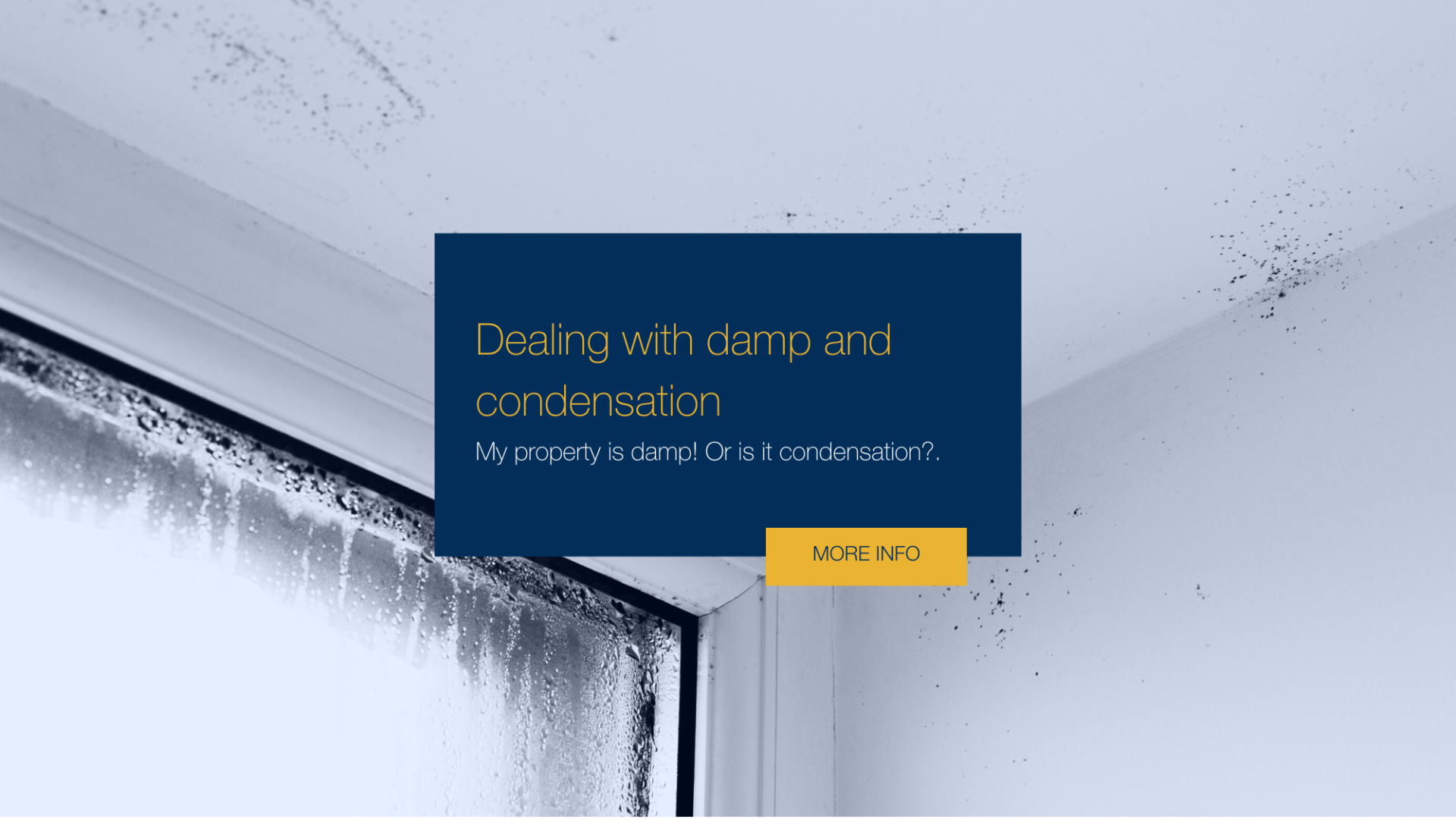Dealing with damp and condensation
 By Shaun Adams
Subscribe to newsletter
By Shaun Adams
Subscribe to newsletterMy property is damp! Or is it condensation?
This is more common in the colder months of the year. If it is all year round and damp coming in from the outside eg rain penetration (from a faulty roof) or rising damp (identified by a characteristic “tide mark” on the lower section of affected walls) then that is a different matter. Most (not all) mildew or mould problems in housing are from condensation. Ventilation is key, any activity that involves water vapour will condense. Ventilation allows moist air to escape. Ventilation is from a slightly open window or an extractor fan. Dehumidifiers also remove moist air.
Where does all the water or steam go from everyday living?
Steam from cooking, ironing, showering, kettles, heaters
Water vapour from drying clothes, bathing and even breathing
It all evaporates into the air, if the air is contained it will condense onto cold surfaces (walls, mirrors, ceilings, windows etc)
These damp areas will form mildew and mould especially where there is less air flow eg In corners of the room, behind furniture and in cupboards and wardrobes.
An average family can produce 10 litres of water vapour per day. Where does this water go?
Condensation is extremely common and affects many homes.
To tackle the problem
1) Stop moisture building up
2) Ventilate, or air the home
3) Use a dehumidifier to extract the moisture laden air
4) Keep your home warm
1. Stop moisture building up
Wipe down surfaces where moisture settles.
Cover boiling pans when cooking.
When cooking, bathing or washing and drying clothes, close kitchen and bathroom doors to prevent steam going into colder rooms, even after you have finished.
Cover fish tanks to stop the water evaporating into the air.
A washing machine with a fast spin will remove more water. Dry clothes outside where possible.
Make sure tumble dryers are vented to the outside or use a condensing tumble drier which collects the water.
Avoid using bottled gas or paraffin heaters as these produce a lot of moisture and could also be a health and safety risk if not used or stored properly.
2. Ventilate or air the home when cooking, washing or drying clothes, open windows or use extractors.
Where drying clothes inside is necessary, do so in a small room always with the windows open.
Open windows for a while each day or use the trickle/night vent. Especially the rooms you sleep in.
Do not block air vents – this is also important where gas and heating appliances are concerned as they need a supply of oxygen to work efficiently and allow gases, such as carbon monoxide, to escape.
Allow air to circulate around furniture and in cupboards – you can do this by making sure that cupboards and wardrobes aren't overfilled and there is space between the furniture and the wall.
In the kitchen keep lids on saucepans, open windows and if you have a ducted extractor hood use it.
In the bathroom is there an extractor fan fitted to remove steam and vapour. If not get one fitted.
3. A dehumidifier will extract the water from the air.
It sucks in the damp air and blows it over cool fins, the air leaving the machine is drier. The water condenses on the fins and drips into a tank. The tank needs to be emptied often. Many people use these all winter. Some can be left on auto setting – just activating when the air is humid.
4. Keep your home warm Draft proofing will keep your home warmer – and help to reduce fuel bills.
When the whole house is warmer, condensation is less likely to form. Make sure external walls are insulated to stop cold patches.
What to do if your home already has mould:
The tips set out should prevent mould but if you already have a mould problem? How do you get rid of it?
Mould is a living organism and needs killing to get rid of it. To do this, wipe down affected areas with a fungicidal wash every day.
Treat any mould you may have already in your home and do what you can to reduce condensation, this will restrict new mould growth.
Mildewed clothes should be dry cleaned and any affected carpet shampooed.
Moulds flourish in damp environments, therefore one of the best ways to prevent their growth is VENTILATION.
Thorough cleaning of the kitchen, bathroom and utility room with subsequent ventilation of these areas will help prevent mould growth. Pay particular attention to walls behind kitchen units and cupboards; the lack of ventilation often means that excess mould grows in these areas.
Open windows and close internal kitchen and bathroom doors when cooking, showering or bathing to prevent steam entering other rooms. Keep bathroom surfaces dry. Do not hang wet clothes inside or over radiators.
Clean mould from window frames and dry condensation.
Do not hang clothes in damp cupboards or pack clothes too tightly in wardrobes. Leave wardrobe doors ajar to ventilate the clothes
Make sure that your tumble dryer is vented outside during use, or use a condenser-dryer. Try not to dry damp clothing indoors.
When showering or cooking, keep internal doors closed to prevent damp air spreading through the house. Use extractor fans and cooker hoods vented outside.
Use a dehumidifier, keep indoor humidity at 50% or less. Empty and clean the reservoir regularly
Important things to remember:
Do not block permanent ventilators. Vents are there for a reason.
Never block a chimney opening.
Use the window trickle vents or keep small windows ajar.
Use extractor fans and dehumidifiers.
Do not draught proof: Rooms where there is condensation or mould growth or Rooms where there is a gas cooker or fuel burning heater, for example a gas fire – or windows in the bathroom or kitchen.
Do not put furniture against cold external walls.
The landlord could be liable if there is a structural fault ie damp proof course problem or rainwater ingress via a leak in the roof. The only course of action open to you is to get your Local Authority to carry out an inspection under the Housing Health and Safety Rating System. If they consider the problem to be serious they can serve an improvement notice on your landlord ordering him to carry out remedial works.
Some properties are affected more than others. Usually older draughtier properties suffer less as the draughts are also ventilation. Some people think it is damp from the outside but this is not the case. Some people think it is because it's cold but garages or sheds don't suffer so that is proved wrong.




 By
By 
 By
By 